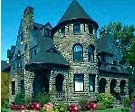

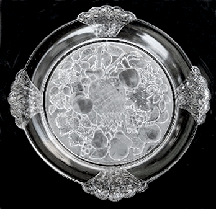 |
 |
| This is a new one on us. Mrs. Sidney Brand sent us photos of this 10" diameter plate to identify & while we recognized the distinctive Gillinder plate handles, we needed Larry Dozier to verify it for us. The center is crammed full of frosted fruit & is indeed another in the Gillinder series of plates that include what some incorrectly call the cartoony 'puck' plates & the toy glass 'Frolic' plate. | |
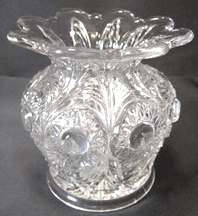 |
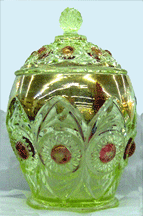 |
| Will we ever find all of the forms & colors made in Bullseye & Fan aka Daisies in Oval Panels - that popular pattern by the U S Glass Co. ca. 1905? On the left is a 'spitoon' made from squashing in the top of a spooner sent to us by someone we can't remember and on the right is a gaudy covered sugar in vaseline with gold trim & ruby 'eyes' - thanks to Sam Kissee. |
|
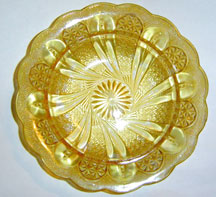 |
 |
| Feather aka Doric pattern by McKee during the 1890s is a popular pattern made in clear, emerald green & amber flashed in alternating 'feathers'. This butter base aberration showed up with amber staining over the entire piece! What did the lid look like...... | Currier & Ives is a product of Co-Op Flint Glass Co. ca 1885 according to Tom Bredehoft. It is rarely found in colors of sapphire blue, amber & vaseline. This 10" wine tray in cobalt blue was pronounced a one-of-a-kind piece by Bill Heacock & the cobalt wine was purchased as part of Heacock's colored wine collection. |
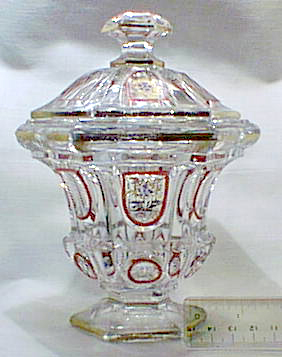 |
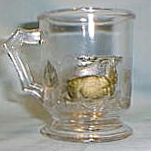 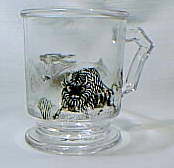 |
| Here's another piece that has us stumped. It's a gorgeous flint cov'd sugar bowl with red and gold paint decor. It's a 'Framed Oval' type pattern from probably the 1840s or '50s but may not be American. | This is a mug in the Gillinder Glass Co. pattern Westward Ho! from the 1880s. One side shows the gilded deer and the other has the charging buffalo. The mug has also been found in blue opaque glass. |
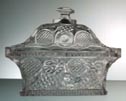  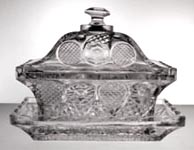 |
This Horn of Plenty covered honey dish and underplate has the distinction
of having brought the highest price for a single piece of Early American
Pattern Glass as of the time of its sale; purchased in 1998 at auction
for $14,000. The dish is 6 1/2" long, 4" wide, 3" high
and 5 1/2" overall
height with the lid. The tray is 7" long by 4 1/2" wide. None
of the known references for this very rare piece mention the existence
of the undertray. We are indebted to the owners for their generosity
in letting us post a photo of it in our museum for the enjoyment of
our visitors. |
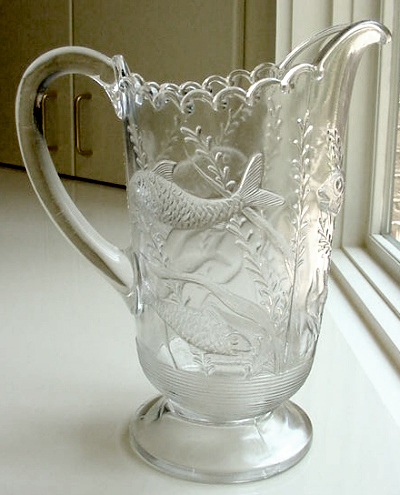 |
 |
Aquarium pitcher- an example of creative glass
made in green and amber also. According to McCain, made by the US Glass
Co after 1909. -"on loan" to the Museum from Cathy Brinsfield of Kitchen Sink Antiques |
This is a scarce 4" sauce dish
in cobalt blue Scalloped (Late) Diamond Point aka Central #439 ca 1870's. Central made some compotes in this pattern in combinations of cobalt and clear glass. |
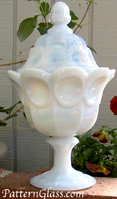 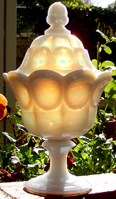 |
| A spectacular and very rare flint covered sugar
bowl in a Colonial pattern made ca 1850's. It is 9 3/4" tall! The photo with the sun shining on it exhibits the meaning of the term "fiery opalescence" relating to early milk (aka opal) glass. |
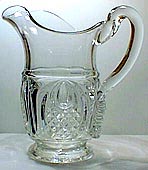 |
 |
Another one of those masterful water pitchers from
the Civil War era. This one is the New England Pineapple pattern by
Boston Sandwich Glass Co ca 1860. Note the large amount of excess glass
at the base of the applied handle. |
A very rare vaseline opalescent relish dish in
the Diamond Spearhead aka Diamond Spearpoint pattern by Northwood ca
1900. The pattern was produced in clear and opalescent colors of blue,
green & canary (vaseline). Surprisingly, this relish dish is one
of the rarest forms of the pattern. |
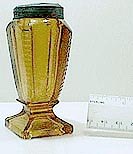  |
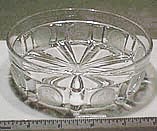 |
An amber shaker in the pattern Jersey
Lily Ware aka Lily Langtree,
previously known as Center Medallion until the discovery of an original
Riverside Glass Co catalog in the summer of 2000. It was made ca 1880s
and this shaker is the only piece of the pattern in color to our knowledge. |
A U S Coin aka Silver Age berry bowl in a size
seldom seen- 6" diameter and 1 3/4" high; not even pictured
in the book about the pattern. This pattern was made by the U S Glass
Co. using actual U S coins in the molds for 6 months in 1892 until
the Feds found out and confiscated all the molds. All pieces of the
pattern which was made with both frosted and clear coins are expensive
and several have been reproduced. |
 |
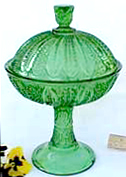 |
| This bread plate in the Lee's Swan aka Netted Swan pattern (ca 1882) is a very special piece of pattern glass to the Virtual Museum curators. Years ago, we gifted it to the man who helped us learn about EAPG. In 1999, the estate of our friend & "mentor" was sold at auction and very good friends, knowing what it meant to us, bought it at a premium price and gifted it back to us! | This is a rare piece of Feather aka Doric
EAPG. It is a green |
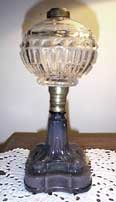 |
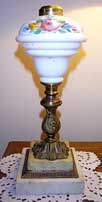 |
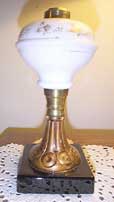 |
| This lamp has a font with the Triple Flute and Bar pattern and a pressed base in an extremely scarce color, "mahogany." The base pattern has multiple names and was produced by at least three companies, Boston & Sandwich, Atterbury, and the American Hot-Cast Porcelain Co. Rare in any color. | This is a transitional period lamp, 1850-1865. The transition being from heavy oils & volatile fluids to Kerosene. The opaque white font is pressed and painted with the upper most ring compatible with a brass prism ring. The cast brass stem was originally produced as a candlestick stem in the 1830s. Whaleoils, Camphene, Burning Fluids and Kerosene would all be appropriate for this lamp when new. | With its molded opaque white font, brass connector, glass stem and black glass base, this lamp is scarce due to these elements being combined within one lamp. The stem is painted copper inside with the pattern also on the inside (a rare element). It is thought to be a product of The Mt. Washington Glass Co. due to a raised "1" on the underside of the base and it's possible reference within an early catalog of that firm. |

